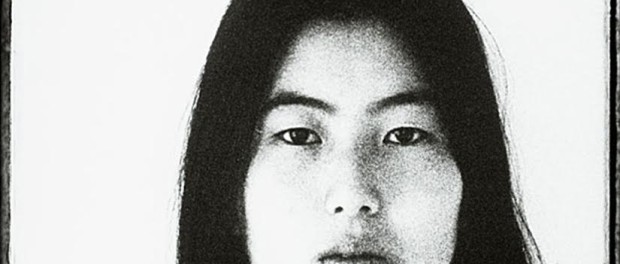Interview with Monika Kin Gagnon: Sight, Sound and Immatériel
Ephemeral, multi-dimensional and paradox: these words come to mind when thinking about the Phi Centre’s latest collaboration with the DHC/Art foundation, /Immatériel/, a collection of Theresa Hak Kyung Cha’s work curated by Monika Kin Gagnon. Similar to Cha’s body of work, the exhibit intertwines viewers’ senses of sight and sound. We read, watch, listen, look and even touch – there is an interactive screen for viewers to explore more of Cha’s works in the Berkeley Art Museum’s archives, as well as a table with some of Cha’s published writings to leaf through. When the Centre extended the dates of the exhibit, we asked Gagnon if she could answer a few questions for us:
Cassandra Marsillo (CM): You have been studying Cha’s work since 2009, what drew you to her art?
Monika Kin Gagnon (MG): I first read Cha’s work when a poet-friend gave me a copy of Dictée back in the late 1980s, and I was immediately riveted by it. What specifically drew me to her Berkeley archive more recently was her unfinished film, White Dust from Mongolia, which had been interrupted due to student demonstrations in Gwangju, South Korea in 1982. Once I entered the archive and started reading her notebooks, viewing her other short videos and Super8mm films, I became completely fascinated with all of it, especially the media-based work which hasn’t been discussed as much. This dovetailed with my interest in externalizing artists’ creative processes, which happens when you look at archives and unfinished works. Her poetic explorations of language, diasporic identity and attention to materiality are especially interesting to me.
CM: This exhibit was conceived under interesting circumstances, as you only had a small window in which to make use of Cha’s archive at the Berkeley Art Museum. Would you be able to tell us more about the experience and how it helped shape the exhibit?
MG: The Berkeley Art Museum/Pacific Film Archive announced a moratorium on all loans from their collections and archives until 2017 because of a major building renovation they are undergoing. This meant that no original objects were available to borrow. I always intended to focus on the videos and film, Permutations, which are from Electronic Arts Intermix. But I had also intended to include original archival elements, especially descriptions, storyboards, notebooks, related to the mediaworks. Instead I had permission to work from the digital archive which had some technical limitations to reproducibility, and so in some ways, the exact objects kind of self-selected themselves. We embraced the constraints! I decided to incorporate the digital archive as a key conceptual element of the curation and made it more visible: we emulated the finding aid descriptions from the online archive as didactics for the works, and used them to tell a much richer story than might have been otherwise. We brought in the touchscreen to give examples from the online archive that is publicly available.
CM: /Immatériel/ focuses on Cha’s videos, but features other types of artwork as well (written, unfinished work, stills and scripts). Why was it important for you to include these?
MG: I wanted to bring viewers into Cha’s creative processes. The works themselves can be a bit oblique, and I felt that showing the rigour and depth of her working process would widen a viewer’s experience, and also develop interconnections across the individual artworks and media forms. For instance, her unfinished works in the show resonate with the completed videos — words and sound phonetics that recur, images of the single hand, the enactments of linguistic and cultural translation — all start blending into a constellation of ideas, intentions, and materialized sounds and images. People have spoken to me about being very emotional when viewing the show. I feel the same way, but I’m not sure what exactly evokes this quality, I think it is the intimacy of the work.
CM: There is an important link between sight and sound in Cha’s work. How, as a curator, did you translate this into the exhibit?
MG: Her edited collection on film theory, Apparatus, which is included in the show had a huge impact on many of us in the 1980s. It was a sophisticated, rigourous demonstration of film theory and intermedia praxis. Her own contribution, Commentaire is brilliant, evoking sound and phonetics from singular words on the printed book page: comment, taire, tear… How does she do this?! It’s partly how she stretches out our reading processes and breaks down words across English, French. I was mindful of not overcrowding the space with too much to view and read, but providing enough direction and interconnections so that the complex simplicity of her work (as paradoxical as this seems) would come through.
CM: What challenges did you face placing Cha’s ephemeral vision into a space, in this case the Phi Centre?
MG: Strangely, I was initially concerned that we couldn’t adequately fill the gallery space in its entirety. And yet once we started working to place the videos, images and archive didactics, we reworked the relations between elements so they had enough time and space to breathe, and could still retain coherence as a guided journey through her work. The Phi installation team has an amazing sense of the space, too, so they brought their expertise to solve certain installation issues. It was a dream to work with this team.
When asked how she would sum up the experience of visiting /Immatériel/ in one sentence, Gagnon replied, “An intimate journey through the creation and afterlife of Theresa Cha’s intermedia.” I would also add exciting and thought-provoking; this is a rare example of an exhibit that not only captures your being within the space, but that continues to resonate once you step back out into the street as well.
The Phi Centre is open Monday to Saturday from 12-5, and you can catch /Immatériel/ before it closes on April 11






